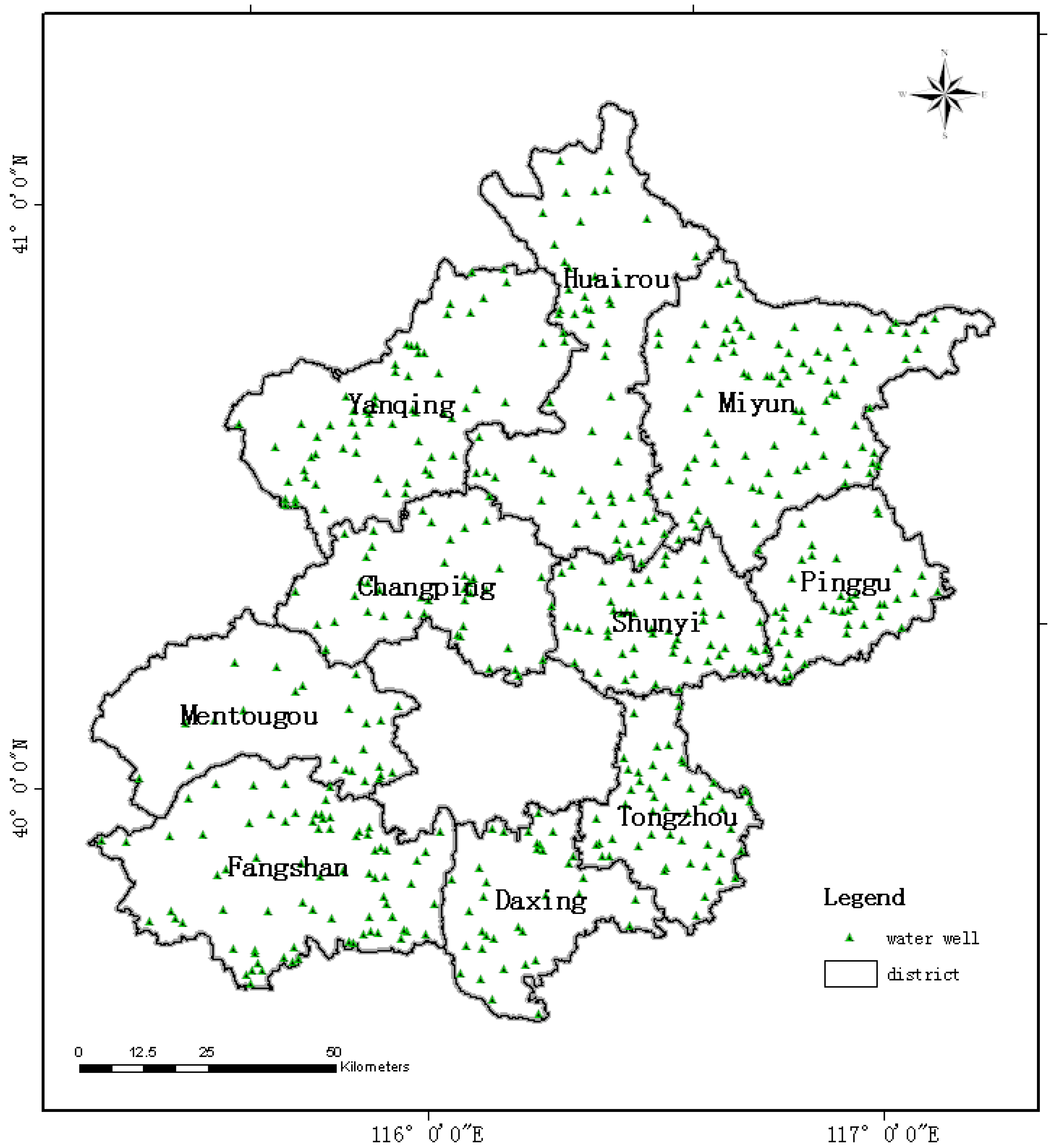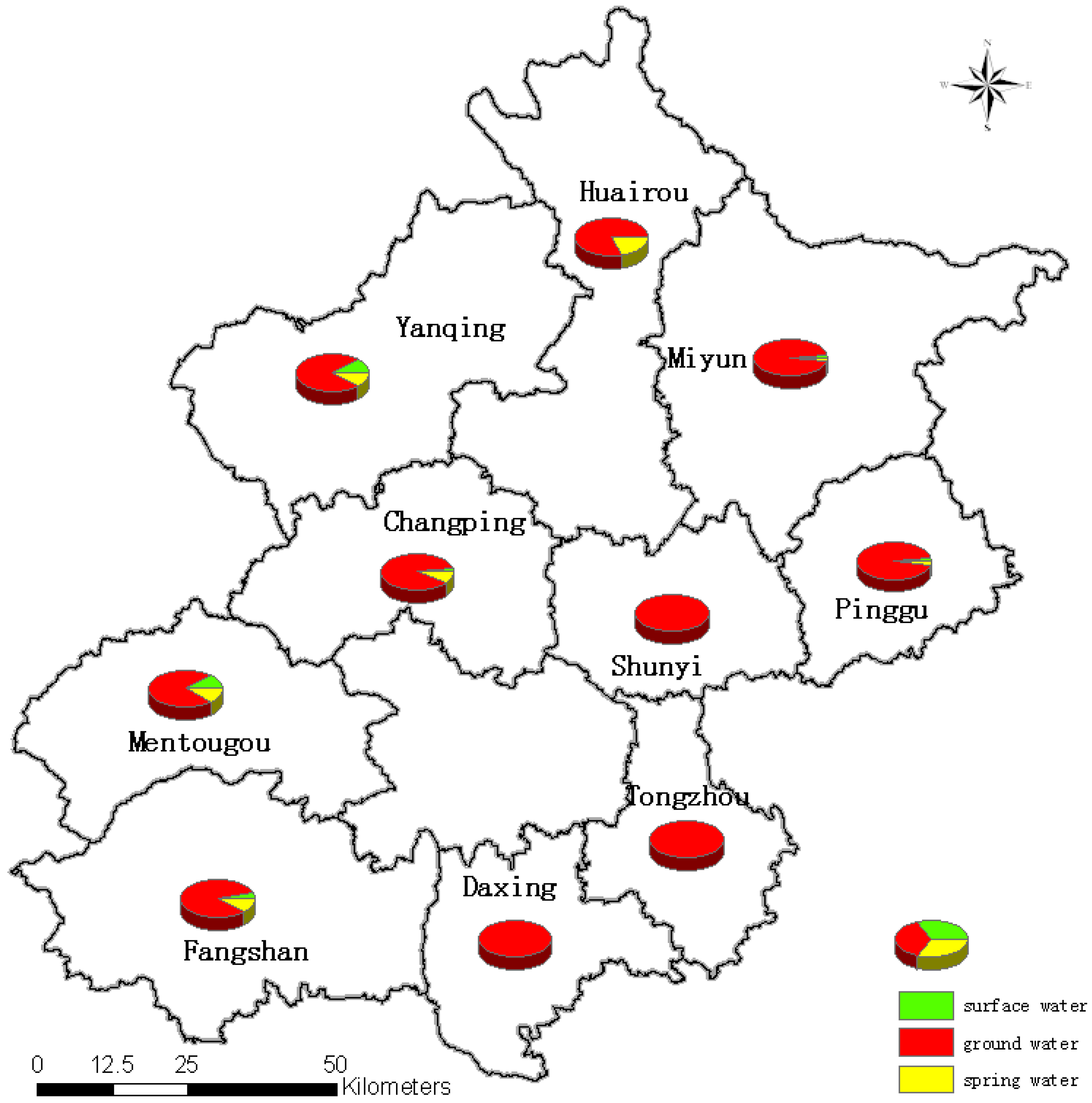Water Sources and Their Protection from the Impact of Microbial Contamination in Rural Areas of Beijing, China
Abstract
:1. Introduction
2. Experimental Section

3. Results and Discussion
3.1. Bacterial Contamination in Drinking Water
3.2. Water Source and Wellhead Protection
| TBC (CFU/mL) | TC (MPN/100 mL) | E. Coli (MPN/100 mL) | TBC (CFU/mL) | TC (MPN/100 mL) | E. Coli (MPN/100 mL) | ||||
|---|---|---|---|---|---|---|---|---|---|
| Changping | N | 172 | 172 | 172 | Miyun | N | 340 | 340 | 340 |
| median | 2 | ND | ND | median | 1,100 | ND | ND | ||
| minimum | ND | ND | ND | minimum | 8 | ND | ND | ||
| maximum | 370 | 201 | 45 | maximum | 4,200 | 23 | ND | ||
| Daxing | N | 140 | 140 | 140 | Pinggu | N | 162 | 162 | 162 |
| median | 2 | ND | ND | median | ND | ND | ND | ||
| minimum | ND | ND | ND | minimum | ND | ND | ND | ||
| maximum | 100 | ND | ND | maximum | 350 | 23 | 23 | ||
| Fangshan | N | 298 | 298 | 297 | Shunyi | N | 208 | 208 | 208 |
| median | ND | ND | ND | median | 6 | ND | ND | ||
| minimum | ND | ND | ND | minimum | ND | ND | ND | ||
| maximum | 800 | 33 | 33 | maximum | 2,900 | 8 | 8 | ||
| Huairou | N | 207 | 207 | 207 | Tongzhou | N | 188 | 188 | 188 |
| median | 16 | ND | ND | median | 2 | ND | ND | ||
| minimum | 1 | ND | ND | minimum | ND | ND | ND | ||
| maximum | 2,600 | 1,600 | 1,600 | maximum | 370 | 8 | 8 | ||
| Mentougou | N | 92 | 92 | 92 | Yanqing | N | 248 | 248 | 245 |
| median | 3 | ND | ND | median | 165 | 3 | ND | ||
| minimum | ND | ND | ND | minimum | ND | ND | ND | ||
| maximum | 150 | 49 | ND | maximum | 88,000 | 1,600 | 201 | ||

| TBC | TC | E. Coli | ||||||||
|---|---|---|---|---|---|---|---|---|---|---|
| N | Sum of Ranks | Z | p | Sum of Ranks | Z | p | Sum of Ranks | Z | p | |
| Well seal | 1,614 | 1,388,953.5 | −8.69 | 0.00 | 1,423,757.0 | −4.95 | 0.00 | 1,435,982.5 | −2.52 | 0.01 |
| Well unseal | 175 | 212,201.5 | 177,398.0 | 161,595.5 | ||||||
| Wellhead above ground level | 1,172 | 793,316.0 | −3.15 | 0.00 | 792,041.5 | −5.47 | 0.00 | 804,776.5 | −2.33 | 0.02 |
| Wellhead below ground level | 209 | 160,955.0 | 162,229.5 | 148,113.5 | ||||||
| Well housing | 1,122 | 703,174.0 | −12.95 | 0.00 | 754,351.0 | −6.57 | 0.00 | 772,928.5 | −1.92 | 0.05 |
| No well housing | 264 | 258,017.0 | 206,840.0 | 186,876.5 | ||||||
| Surface water | 184 | 215,173.5 | −5.43 | 0.00 | 236,630.5 | −12.45 | 0.00 | 220,220.5 | −14.88 | 0.00 |
| Ground water | 1,737 | 1,630,907.5 | 1,609,450.5 | 1,616,265.5 | ||||||
| Well depth | 1,693 | - | 6.22 (t) | 0.00 | - | −30.07 (t) | 0.00 | - | −50.72 (t) | 0.00 |
| 1,693 | - | −0.15 (r) | 0.00 | - | −0.34 (r) | 0.00 | - | −0.11 (r) | 0.02 | |

| District | The number of samples | Well seal | Wellhead above ground | Well housing |
|---|---|---|---|---|
| Changping | 43 | 93% | 93% | 93% |
| Daxing | 37 | 83% | 83% | 83% |
| Fangshan | 80 | 75% | 68% | 20% |
| Huairou | 58 | 73% | 29% | 51% |
| Mentougou | 23 | 87% | 48% | 52% |
| Miyun | 85 | 65% | 69% | 44% |
| Pinggu | 41 | 90% | 87% | 90% |
| Shunyi | 54 | 98% | 98% | 98% |
| Tongzhou | 51 | 98% | 98% | 98% |
| Yanqing | 63 | 72% | 3% | 8% |
3.3. Contamination Sources around Water Sources
| TBC | TC | E. Coli | ||||||||
|---|---|---|---|---|---|---|---|---|---|---|
| N | sum of ranks | Z | p | sum of ranks | Z | p | sum of ranks | Z | p | |
| Sewage ditch | 34 | 5,326.0 | −0.27 | 0.79 | 7,022.5 | −3.24 | 0.00 | 5,373.0 | −0.08 | 0.94 |
| No sewage ditch | 283 | 45,077.0 | 43,380.5 | 44,713.0 | ||||||
| Landfills | 31 | 3,835.5 | −0.73 | 0.47 | 4,131.5 | −0.39 | 0.70 | 3,892.0 | −0.60 | 0.55 |
| No landfills | 225 | 29,060.5 | 28,764.5 | 29,004.0 | ||||||
| Village dry toilet | 420 | 103,948.5 | −2.23 | 0.02 | 101,810.5 | −2.62 | 0.01 | 103,990.0 | −1.91 | 0.05 |
| No village dry toilet | 78 | 20,302.5 | 22,440.5 | 20,261.0 | ||||||
| Livestock farm | 17 | 2,028.0 | −1.15 | 0.18 | 2,668.5 | −2.46 | 0.01 | 2,008.0 | −1.02 | 0.19 |
| No livestock farm | 218 | 25,702.0 | 25,061.5 | 25,722.0 | ||||||
| Polluting industries | 33 | 4,396.5 | −0.40 | 0.69 | 3,311.5 | −2.81 | 0.00 | 4,257.0 | −1.43 | 0.15 |
| No polluting industries | 238 | 32,459.5 | 33,544.5 | 32,599.0 | ||||||
4. Conclusions
Acknowledgments
Conflict of Interest
References
- The State of the World’s Children 2009: Maternal and Newborn Health; UNICEF: New York, NY, USA, 2009.
- Azizullah, A.; Khattak, M.N.; Richter, P.; Häder, D.P. Water pollution in Pakistan and its impact on public health—A review. Environ. Int. 2011, 37, 479–497. [Google Scholar] [CrossRef]
- Cool, G.; Rodriguez, M.J.; Bouchard, C.; Levallois, P.; Joerin, F. Evaluation of the vulnerability to contamination of drinking water systems for rural regions in Québec, Canada. J. Environ. Plann. Manag. 2010, 53, 615–638. [Google Scholar] [CrossRef]
- Emerging Issues in Water and Infectious Disease; World Health Organization: Geneva, Switzerland, 1993.
- Xinhua News Agency. Over 40% of Rural Areas’ Drinking Water Unhealthy, 2008. Available online: www.china.org.cn/english/environment/243133.htm (accessed on 18 February 2008).
- Pitkänen, T.; Karinen, P.; Miettinen, I.T.; Lettojärvi, H.; Heikkilä, A.; Maunula, R.; Aula, V.; Kuronen, H.; Vepsäläinen, A.; Nousiainen, L.L.; et al. Microbial contamination of groundwater at small community water supplies in Finland. AMBIO 2011, 40, 377–390. [Google Scholar] [CrossRef]
- Wu, W.Q. Yearbook of China Water Resources; China Water & Power Press: Beijing, China, 2010. [Google Scholar]
- Wei, J.; Ye, B.X.; Deng, Y. Report on Monitoring of Drinking Water in Rural Areas of Beijing; Beijing Center for Disease Control and Prevention: Beijing, China, 2010; in Chinese. [Google Scholar]
- Chinese Standards. In GB/T 5750.12-2006, Standard Examination Methods for Drinking Water—Microbiological Parameters; Standards Press of China: Beijing, China, 2006.
- Standard Methods for the Examination of Water and Wastewater; American Public Health Association: Washington, DC, USA, 2005.
- Guidelines for Drinking-Water Quality; World Health Organization: Geneva, Switzerland, 2006.
- Water, Sanitation and Hygiene Annual Report 2008; UNICEF: New York, NY, USA, 2008.
- Wallrabenstein, L.K.; Richards, R.P.; Baker, D.B.; Barnett, J.D. Nitrate and Pesticides in Private Wells of Indiana; Indiana Farm Bureau, Inc.: Indianapolis, Indiana, 1994. [Google Scholar]
- Zimmerman, T.M.; Zimmerman, M.L.; Lindsey, B.D. South-Central and Southeastern Pennsylvania (Report 01-4206); U.S. Geological Survey, Water-Resources Investigations: New Cumberland, PA, USA, 2001. [Google Scholar]
- Gonzales, T.R. The effects that well depth and wellhead protection have on bacterial contamination of private water wells in the Estes Park Valley, Colorado. J. Environ. Health 2008, 71, 17–23. [Google Scholar]
- Antony, M. Water: Chemistry and Quality. In Industry and Wildlife: A Manual of Principles and Practices; Wildfowl & Wetlands Trust: Slimbridge, UK, 1994; Volume Chapter 5. [Google Scholar]
- Ashbolt, N.J. Microbial contamination of drinking water and disease outcomes in developing regions. Toxicology 2004, 198, 229–238. [Google Scholar] [CrossRef]
- Plummer, J.D.; Long, S.C. Monitoring source water for microbial contamination: Evaluation of water quality measures. Water Res. 2007, 41, 3716–3728. [Google Scholar] [CrossRef]
- Abu, A.S.S.; Yassin, M.M. Microbial contamination of the drinking water distribution system and its impact on human health in Khan Yunis Governorate, Gaza Strip: Seven years of monitoring (2000–2006). Public Health 2008, 122, 1275–1283. [Google Scholar] [CrossRef]
- Christensen, T.H.; Kjeldsen, P.; Albrechtsen, H.J.; Heron, G.; Nielsen, P.H.; Bjerg, P.L.; Holm, P.E. Attenuation of landfill leachate pollutants in aquifers. Crit. Rev. Environ. Sci. Technol. 1994, 24, 119–202. [Google Scholar] [CrossRef]
- Ludvigsen, L.; Albrechtsen, H.J.; Heron, G.; Bjerg, P.L.; Christensen, T.H. Anaerobic microbial redox processes in a landfill leachate contaminated aquifer (Grindsted, Denmark). J. Contam. Hydrol. 1998, 33, 273–291. [Google Scholar] [CrossRef]
© 2013 by the authors; licensee MDPI, Basel, Switzerland. This article is an open access article distributed under the terms and conditions of the Creative Commons Attribution license (http://creativecommons.org/licenses/by/3.0/).
Share and Cite
Ye, B.; Yang, L.; Li, Y.; Wang, W.; Li, H. Water Sources and Their Protection from the Impact of Microbial Contamination in Rural Areas of Beijing, China. Int. J. Environ. Res. Public Health 2013, 10, 879-891. https://doi.org/10.3390/ijerph10030879
Ye B, Yang L, Li Y, Wang W, Li H. Water Sources and Their Protection from the Impact of Microbial Contamination in Rural Areas of Beijing, China. International Journal of Environmental Research and Public Health. 2013; 10(3):879-891. https://doi.org/10.3390/ijerph10030879
Chicago/Turabian StyleYe, Bixiong, Linsheng Yang, Yonghua Li, Wuyi Wang, and Hairong Li. 2013. "Water Sources and Their Protection from the Impact of Microbial Contamination in Rural Areas of Beijing, China" International Journal of Environmental Research and Public Health 10, no. 3: 879-891. https://doi.org/10.3390/ijerph10030879





